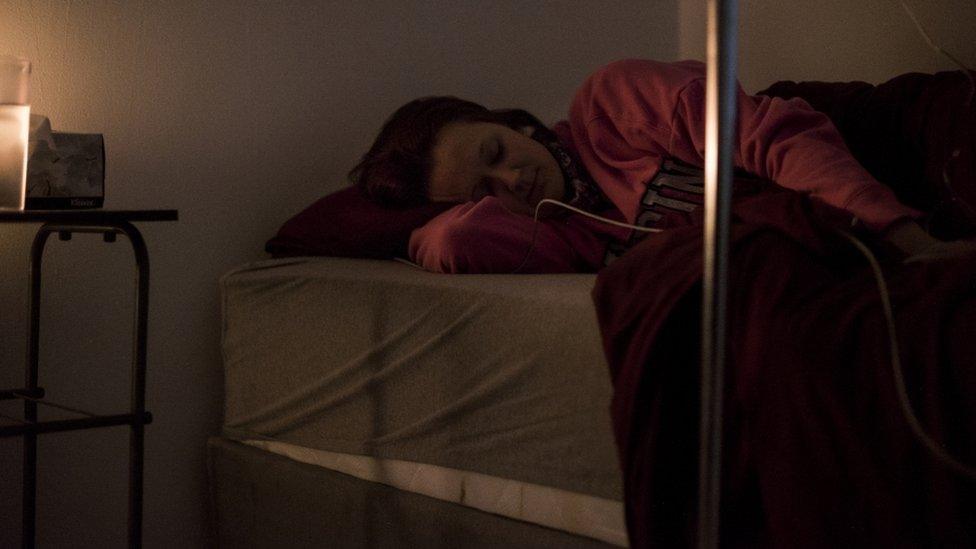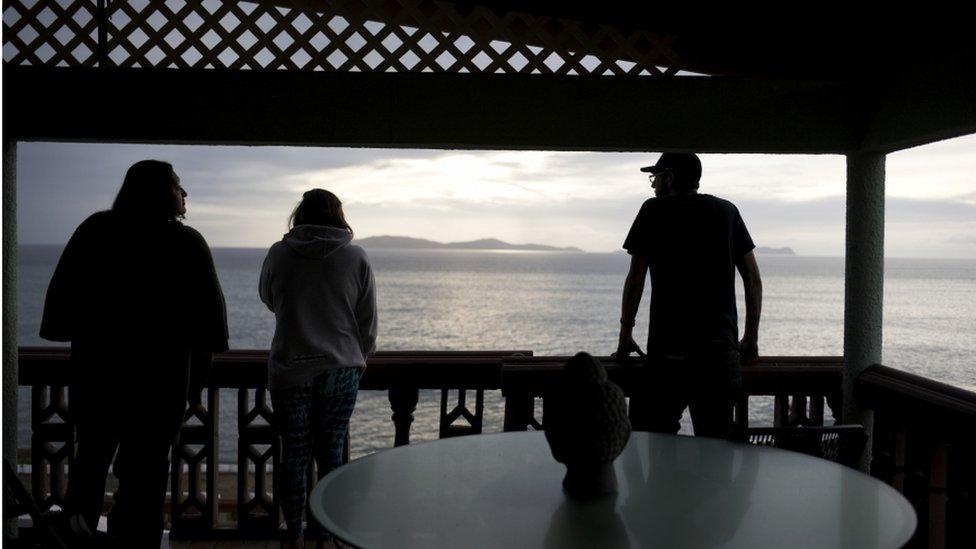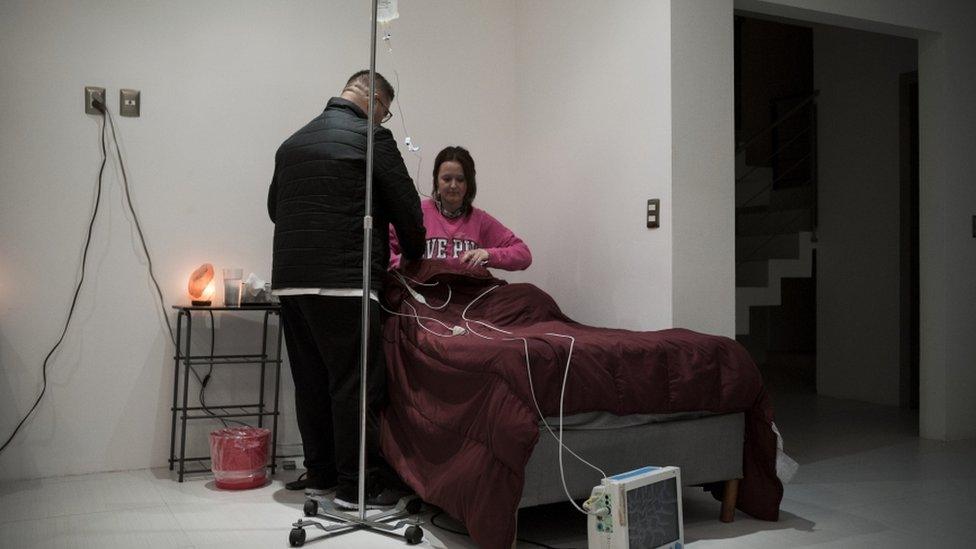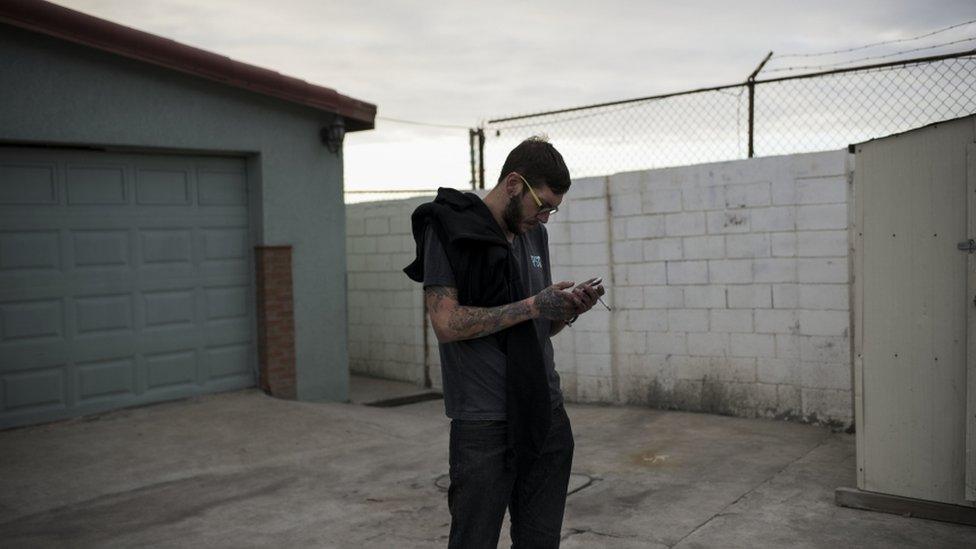Americans going abroad for illegal heroin treatment
- Published

Emily Albert begins her treatment to try and end years of opioid and heroin abuse
As America's opioid and heroin crisis rages, some struggling with addiction are turning to a drug illegal in the US. Jonathan Levinson went to one clinic offering the treatment in Mexico.
At the end of a dead end street in a town near the US-Mexico border, Emily Albert is in the basement of a drug treatment clinic, hallucinating about her son as a heroin addict. She imagines him going through rehab and desperately trying to get clean.
But Albert is the one with the addiction. She's in the middle of a psychedelic treatment for opioid addiction.
Through tears after the treatment is over, Albert recalls the vision of her son.
"I could just tell that he was older and going through whatever I'm going through," she explains. "It was like, basically, if I don't do this then he's going to have to."
Albert is among a growing number of opioid addicts from the US going to clinics in Mexico to get treated with a psychedelic drug called ibogaine.
The drug is illegal in the US, but several studies have suggested it is effective in alleviating opioid withdrawals and curbing addiction.
And unlike daily replacement therapies like buprenorphine or methadone, ibogaine only requires a one-time treatment.

Ibogaine risks and legality
Ibogaine has been associated with at least 19 deaths. Given it is largely unregulated, the actual toll could be much higher
In New Zealand, the only country to have regulated the drug, the medical advisory board Medsafe reported that "the number of deaths due to methadone, the most controlled substance, were a little higher that those associated with ibogaine"
Ibogaine is illegal in the US, France, Sweden, Denmark, Belgium, Poland, Croatia and Switzerland and strongly restricted in the UK under the 2016 Psychoactive Substances Act, external

Ibogaine, along with other hallucinogenics, such as LSD and psilocybin (magic mushrooms), are schedule I substances in the US - drugs which have no medical application and are not safe for use, even under medical supervision.
The drug's side effects include hallucinations, of course, but also seizures and in rare cases, potentially fatal cardiac complications.
Still, there is a growing body of evidence suggesting the FDA's label isn't accurate.
"Essentially, it's because of the backlash against the psychedelic '60s," says Dr Thomas Kingsley Brown, an anthropologist and chemist at the University of California, San Diego.
In a study spanning eight years, funded by the Multidisciplinary Association on Psychedelic Studies, or MAPS, Brown tracked outcomes for addicts who were treated with ibogaine, external.
"About 90% of the people in the study had a dramatic reduction in their withdrawal symptoms at the point when you'd expect they'd be at their worst," he says.
Brown says the severity of their addictions were reduced throughout a 12-month follow-up period and their relationships with family and loved ones improved as well.

Staff at the clinic look out over the coast, where whales are swimming
Two days after her own ibogaine treatment, Albert is sitting on a deck at the clinic overlooking the Pacific Ocean when it dawns on her that she hasn't even thought about getting high in two days.
That hasn't happened in 10 years.
"It's like they took my addiction and put it in an elevator and sent it a hundred floors down," she says.
When Albert was 14, she had minor surgery on her big toe after a basketball injury. The doctor prescribed Percocet for the pain.
"I remember the very first time I tried one. I didn't know if it was the antibiotics my mom had given me or what it was from those bottles, but I was like 'that is great. I'm going to figure out what that was.'"
Over the next few days she tried one, then another. When she finally figured it out, she says, "it was game over from there".
She quickly went from pills to heroin. And when she had to worry about passing drug tests she'd huff cans of compressed air - sometimes up to 16 cans a day.
Because ibogaine is illegal in the US and not well known, the people with addiction who end up in Mexico seeking treatment are typically there as a last resort.
Two days before Albert's treatment she was coming off a stretch of homelessness, barricaded in a hotel room north of San Diego. She wasn't answering the door or her phone and an employee from the clinic, sent to pick her up, feared she might have overdosed.
When she finally did answer, a brief stand-off ensued.
"She's going to have to leave with you or leave with the police," Thom Leonard, who owns the clinic, told the employee over the phone.
She chose rehab.
Treatment at this clinic costs between $5,000 and $12,000, depending on the length of stay and programme. Emily's parents ended up paying for her treatment, but Leonard says he does discounts and pro-bono treatments for those who can't afford to pay. Those who pay full price subsidise those efforts.

Emily Albert is hooked up to an EKG before she begins her ibogaine treatment
While this clinic has a good reputation among independent researchers, ibogaine treatment clinics in Mexico and elsewhere are unregulated, making it difficult to determine the level of medical knowledge and safety on offer.
And while Ibogaine shows promise, it comes with risks. People have died while taking it.
Between 1990 and 2008, 19 people are known to have died within 72 hours of taking Ibogaine. Researchers at NYU looked at autopsy and toxicological data, external from those deaths and found that most patients had pre-existing cardiac or liver conditions, or still had opioids in their system, all of which are contraindications for Ibogaine.
A 2015 review found similar issues, external in three additional deaths, and reports of dangerously slow heart rate associated with taking the drug.
And so the morning after she arrived, Albert was taken to get blood tests and an EKG exam to make sure she was healthy enough for treatment.
That night, in a dimly lit room, a nurse inserted an IV, hooked Albert up to an EKG for monitoring throughout her treatment. Then a doctor gave her three ibogaine pills.
With calming, instrumental music playing, Albert appeared to fall asleep.
Aside from the occasional bathroom break or scream you might expect to hear from someone having a bad dream, she stayed like that for more than 24 hours.
Meanwhile she was experiencing vivid hallucinations.
"There was a childhood memory that I didn't know was there," she recalled. "It kept going around and around and every time I'd get a little more."
Leonard says that's an important part of the process.

Thom Leonard outside his clinic
"You revisit your traumas, but you see them from a new perspective. And you get to make peace with these things - or at least move past them."
The science behind ibogaine's efficacy in treating addiction is up for debate.
A 2008 study in mice by neurologist Dorit Ron found, external ibogaine increased the level of a brain protein called GDNF, which prevents the development of addiction.
There are drugs that mimic some of ibogaine's effects.
Savant HWP, an American pharmaceutical company, is scheduled to begin human trials next year on a drug called 18-MC, which claims to have ibogaine's desirable effect on addiction - without the hallucinogenic component.
But people familiar with ibogaine's use in treating addiction believe the psychedelic experience is critical to the treatment.
Brown says the drug is probably allowing new nerve connections to be formed. But, he adds, "psychological experiences are also creating changes in the brain".
"It's not quite as simple as, once this is in your body it's helping to rewire things. There is an interplay with the psychology."
Brown, Ron and other researchers who are interested in ibogaine say there's still more research needed on safety and whether the hallucinations are critical to curbing addiction. Its status as an illegal drug, however, makes that difficult.
So what are the prospects of a hallucinogenic, schedule I substance being approved for medical use in the US?
The heroin-ravaged city fighting back
Not as slim as one might think.
The FDA just approved Phase III trials for MDMA - the active component in Ecstasy - to study its use in treating post-traumatic stress. Brown believes it is likely to show good results and be approved.
If it does, he says, that will have an enormous impact on public opinion.
In the meantime, while the opioid epidemic in the US has slowly raised awareness of ibogaine, Leonard says that as an industry primarily run by former addicts, legitimacy has been a struggle.
To his dismay, he says Google Ad Words banned ibogaine ads last year. Leonard estimates he lost 60% of his referrals.
"There is so much stigma around being an addict and so it's hard for people to take us seriously sometimes."
Meanwhile, two months after her treatment, Emily is still clean.
Jonathan Levinson is a reporter and photographer based in Mexico. This story was originally published at PRI.org. Public Radio International (PRI) co-produces The World with the BBC World Service and WGBH.